Intermarkets' Privacy Policy
Donate to Ace of Spades HQ!
aceofspadeshq at gee mail.com
Buck:
buck.throckmorton at protonmail.com
CBD:
cbd at cutjibnewsletter.com
joe mannix:
mannix2024 at proton.me
MisHum:
petmorons at gee mail.com
J.J. Sefton:
sefton at cutjibnewsletter.com
World's Largest Ball Of ONT
Fri-Yay! Cafe
Trump Proposes Rule to Make Big Pharma Sell Its Drugs to Americans at Same Price They Sell It To Europeans, Reducing Drug Costs by Up to 90%
Plus: More Quick Hits
Quick Hits
Mortgate Rates Fall to Lowest Level In Three Years As CNN Grieves
Trump Again Warns Walz and Frey: Start Enforcing the Law, Or Federal Troops Are Coming
For Some Reason AP and ABC "News" Cannot Even Guess At, Overdose Deaths In the US Plummeted in 2025
Thwarted True Venezuelan President Presents Her Nobel Peace Prize to Trump
As SCOTUS Debates "Trans Women" Competing in Girls Sports, the World's 671st Ranked Male Tennis Player Easily Beats the Woman Ranked #1; also, Remembering Scott Adams and Dilbert
Jim Sunk New Dawn 2025
Jewells45 2025
Bandersnatch 2024
GnuBreed 2024
Captain Hate 2023
moon_over_vermont 2023
westminsterdogshow 2023
Ann Wilson(Empire1) 2022
Dave In Texas 2022
Jesse in D.C. 2022
OregonMuse 2022
redc1c4 2021
Tami 2021
Chavez the Hugo 2020
Ibguy 2020
Rickl 2019
Joffen 2014
maildrop62 at proton dot me
TBD
Saturday Gardening Thread: Doctor! Doctor! [Y-not, KT...]
Y-not: Good afternoon, gardeners! Today's thread is brought to you by The Thompson Twins:
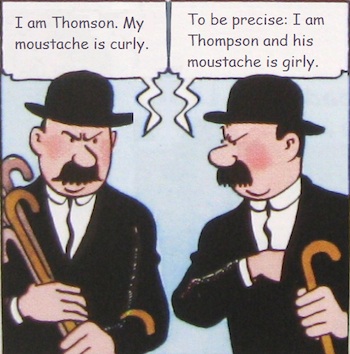
Fun fact here.
Doctor! Doctor!
Our own CharlieBrown'sDi sent me pictures of his roses, which appear to be under attack.
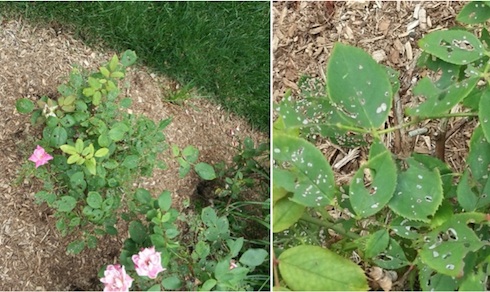
SF Gate lists several pests that attack rose leaves, including caterpillars, beetles (such as the fuller rose beetle), sawflies, and leaf-cutting bees.

He tells me that they were planted last summer. Do any of our rose experts have advice for him? The moron (or 'ette) who provides CBD with the best suggestion wins a Platinum Membership to his Sunday Food Thread.

I got better.
A friend of mine was telling me that there is a hotel or restaurant (I think) in Nashville that features American Chestnut Trees. I wasn't able to confirm that it still exists, but in the process of looking for that I found out that the American Chestnut Tree is making a comeback:
One of the great autumn pastimes of the 1800s was nutting* -- where families, friends and farmers went around clubbing stately chestnut trees, or shinnying up 100-foot tall trunks to pound the branches. A fusillade of nuts would fall to the ground and be scooped up instantly, to be transformed into pan-fried bread, porridge, pickles, preserves, cream pie -- and countless other nutritious favorites of colonial times.Then, in the early 1900s, a plague decimated American chestnut trees. The deadly fungus, known as blight, caught a ride to the U.S. on a much smaller and fungus-resistant Chinese chestnut. The stately, soaring American tree was utterly vulnerable. Almost overnight, a quarter of our Eastern forests -- 4 billion trees --vanished and with the trees went a nut that for centuries had nourished wildlife and humans alike.
But now, the American chestnut could return as a bionic, blight-resistant tree, thanks to genetic engineering and a group of dedicated forest "biotechnologists" at the State University of New York College of Environmental Science and Forestry's American Chestnut Research & Restoration Project.
*No, not THAT kind of nutting. Pervs. -ed.
Here's a video about the project, courtesy of the American Chestnut Foundation:
With seemingly so many Bad Science stories in the news these days, it's nice to see a Good Science one.
Get Well Soon!

In the second half of the nineteenth century the pollution of urban centres made the divide between town and country startlingly clear to many. Bringing a little of the country and suburbs to the inner city, however, were the Flower Missions, voluntary organisations that distributed flowers to the sick and poverty-stricken with messages of hope and comfort.
I don't know if he's a missionary (frankly, the answer may be TMI!), but Misanthropic Humanitarian sent along some beautiful pictures from his flower gardens. Perhaps they will have a healing effect on CBD's sick roses!
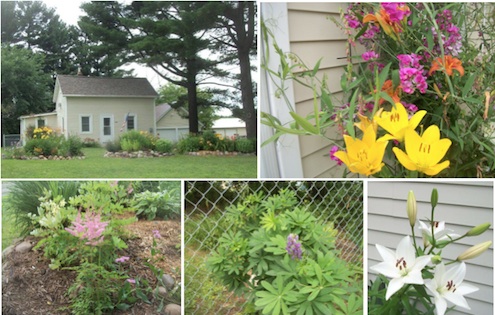
What a beautiful garden! That's bound to make anyone who is under the weather feel better.
Now, let's see what KT and Weirddave have for us this week...
Last week, Dr. Mabuse reported that a large part of a tree had broken off as a result of high winds. Expensive. Ouch. I suggested that we could do more in the future on trees for the landscape.
I am afraid that this has sent my mind off on some serious tangents this week regarding the Sunset Western Garden Book, from which I have learned a great deal about trees and other plants. I liked the related Sunset Magazine more when I lived in Southern California. The South-Central San Joaquin is in the Northern California circulation area, and much of the gardening advice in the magazine is more applicable to the Bay Area than to us.
The Sunset Magazine has an interesting history which I think provides a window into American history and culture. "Sunset began in 1898 as a promotional magazine for the Southern Pacific Transportation Company, designed to combat the negative "Wild West" stereotypes about California."
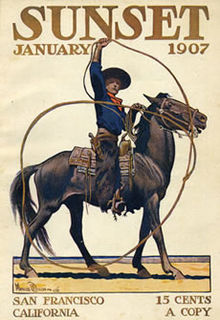
From an early issue, here are some social notes from Pasadena: "The aristocratic residence town of Southern California and rendezvous for the traveling upper ten has enjoyed a remarkably gay season and the hotel accommodations have been sorely taxed."
The Sunset Limited which carried the "Upper Ten" to California once ran from New Orleans to San Francisco. It now runs on Amtrak lines from New Orleans through San Antonio to Los Angeles. Reminder: The only part of the transcontinental railroad that did not go bankrupt was the one that got no government subsidies.
The Sunset Magazine lost its offices to fire after the 1906 San Francisco Earthquake. In 1914, the railroad sold the magazine to some of its employees, who made it into a general-interest magazine, politics and all, during the World War I era. It lost money and was sold to the Lane Publishing Company, which made it into something resembling the western answer to Better Homes and Gardens.
The editorial focus changed with the times. Over the years, the magazine has featured the work of famous authors, artists and experts in several fields. During the Great Depression, it became more "frivolous." The "Western Living" theme later made the magazine popular.
In 1990, Lane sold Sunset to Time Warner. Sunset was placed in a corporate division with Southern Living (sometimes linked on a Saturday Gardening Thread). Southern Living shows quite a resemblance to Sunset.
A while ago, we touched on World War II Victory Gardens and Olivia de Havilland's recollections of FDR’s views on gardening from a rival publication to Southern Living, Garden and Gun. During WWII, Sunset noted that the Victory Garden tips being issued by the federal government did not fit western conditions very well. Employees planted a one-acre Victory Garden near UC Berkeley so they could do first-hand reporting. Perhaps this Victory Garden was not too far from where Occupy took over a UC Berkeley research farm to create a...farm, as documented by our very own Zombie. Their version of a Victory Garden did not turn out particularly well. Cultural Marxism can be a strange thing.
Sunset thrived during the post-war era. In 1951, the magazine established its famous headquarters on a 9 acre parcel in Menlo Park, south of San Francisco. If you want to visit the gardens, better do it soon, because at the end of the year, they will be moving to Oakland.
Zoning Out -- Beyond USDA Hardiness Zones
As seen in Y-not's useful Saturday Gardening Thread Archive, one of the topics discussed in the very first Yard and Garden Thread was USDA Plant Hardiness Zones. This is the zoning system most people mean when they ask, "What is your climate zone?" And it is the system most often used by plant vendors. But there are other zoning systems with relevance to growing plants.
The original climate zones were Aristotle's Torrid, Temperate and Frigid Zones. Today, we know much more about where civilization can survive. The "Tropical, Temperate and Polar Zones" are modern equivalents.
In 1928, German climatologist and amateur botanist Wladimir Koppen introduced a general climate map of the world that took more factors into consideration. A modification of his map divides the world into six general climate regions with several subcategories. It is more sophisticated than the USDA system in some ways, but I have never seen it used in popular reference to gardening.
The American Horticultural Society devised a Heat Zone Map specifically geared to gardeners, like the USDA winter hardiness map. "The 12 zones of the map indicate the average number of days each year that a given region experiences "heat days" -- temperatures over 86 degrees (30 degrees Celsius). That is the point at which plants begin suffering physiological damage from heat. The zones range from Zone 1 (less than one heat day) to Zone 12 (more than 210 heat days)."

Heat Zone Map Explained With some good gardening advice
Together, the USDA and AHS maps can give Eastern gardeners a pretty good idea which plants will thrive in their gardens. But in the West, climate differences can be subtle due to marine vs. interior influences and other factors.
The best thing Lane Publishing did while it owned Sunset was to introduce the Sunset Western Garden Book, with its very specific Sunset Climate Zones. There were originally 24 climate zones designated for the Western United States and parts of Canada. Later, additional climate zones were added for Hawaii and Alaska.
The book also includes very useful information on specific plants, and guides to growing plants. The list of expert contributors to the early editions was extensive. It is rare to see people from different organizations cooperate so successfully today.
Like many gardening nuts, I have several editions of the Sunset Western Garden Book. Over the years, its planting guides and plant descriptions have changed. In the Plant Encyclopedia section of the book, the latest edition has replaced cross-references between common and scientific names of plants with photos of plants. I do not have the ninth edition, but if you want to buy it (or past editions) you can purchase them using Ace's Amazon thingy.

Sunset Western Garden Book, Eighth Edition
In 1997, Sunset published a National Gardening Book that extended its system of regional climate zones throughout the nation. The book never really took off, but you can still purchase copies at Amazon. You can find your nation-wide Sunset Climate Zone here. "Microclimates" you may find in your own yard are also discussed.
Trees in the Sunset
One of the most useful parts of my Eighth Edition (and some earlier editions, and probably the Ninth Edition) of the Sunset Western Garden Book is the section on trees from the basic landscaping guide. Trees are divided into groups according to where they will fit best in the landscape:
Patio trees, deciduous or evergreen
Small to medium trees (may not be suitable near living areas)
Large trees, deciduous or evergreen
Other sections of the planting guide make tree suggestions based on things like foliage color, wind resistance and adaptability to special circumstances.
Sunset on the Web

Before the internet was much of a thing, Sunset produced a nifty interactive CD for selecting trees. That old Sunset tree selection CD seemed like a good idea to me, but I wasn't planting landscape trees at the time. In 2009, Sunset got ambitious and announced an online Plant Finder, which seemed to greatly expand this concept to include other garden plants. It allowed you to input desired plant characteristics such as height, width, color of leaves or flowers, etc. plus your zip code. Your zip code was linked to your national Sunset Climate Zone.
The idea was to provide a list of plants that would fit your needs. Unfortunately, it was frustrating to use. You had to play around with your search criteria to get meaningful results. The magazine has apparently quietly retired this online "tool." In its place, you find eye candy, mostly, like 50 dahlias to drool over.

The only vestige of the old tree selection CD I could find on the Sunset website was this piece on eight factors to consider when choosing a tree for your garden. It will be interesting to see if the National Sunset Climate Zones become more widely known and used in the future.
In the meantime, gardening Morons and Moronettes in the West will likely find the book easier to use than the website. Some may find the Sunset magazine or how-to books interesting, especially if building or landscaping projects are contemplated. For those in the East, there is always the Saturday Gardening Thread. Heh.
Weirddave
OK, well, last week I asked for garden pictures from Morons in the sidebar, and here's what I got:
First off, from poster sifty, we have this example of growing a lot in a small space:

I wonder if he's going to get any production from that corn patch? I've never had much luck with corn.
Next we have 3 different views of what looks to be a lovely and etensive garden from bossybarb:
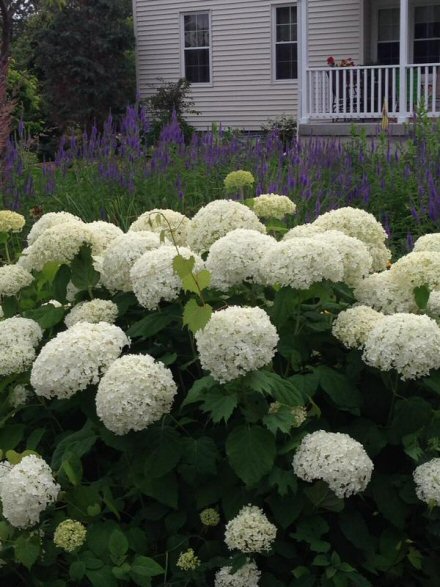


Momom though a picture of her deer fence might be appropriate:

Cute, but wht kind of seeds ddi you grow them from Mommom?
And finally Gingy forwarded me some pics of day lilies, but I'm not sure from whom. The name of each variety is below the picture:
Night Beacon
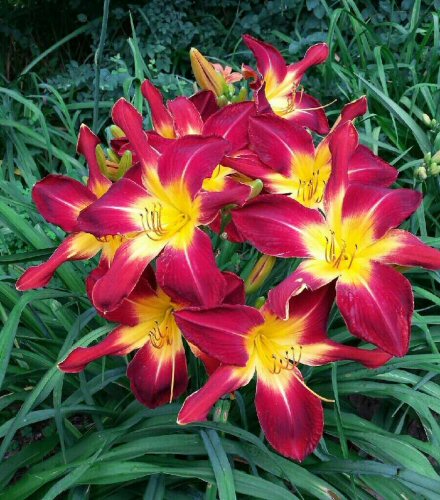
Ruby Spider
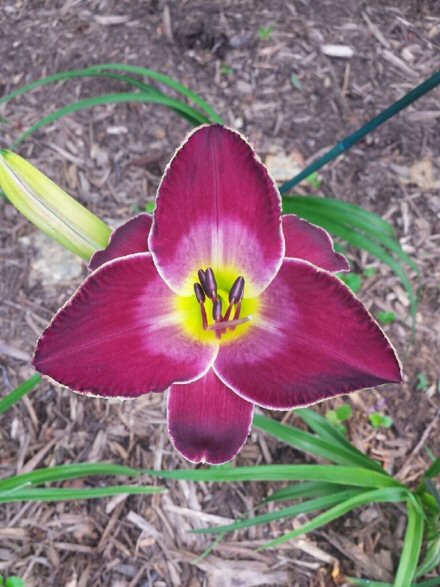
Lounge Lizard
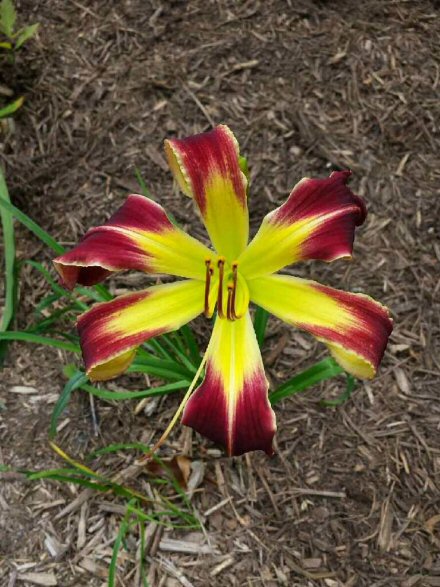
Even Stephen
And that's all I got, I had hoped for a bigger response, frankly I feel a little like Chris Knight in Real Genius:
We plan this thing for weeks and all they want to do is study. I'm disgusted. I'm sorry but it's not like me, I'm depressed. There was what, no one at the mutant hamster races, we only had one entry into the Madame Curie look-alike contest and he was disqualified later. Why do I bother?
Just kidding. Anyone that wants their garden featured in future threads, forward the pics to me.
Back to you Y-not.
Y-not: To wrap things up, here's a song inspired by Misanthropic Humanitarian's garden:
(By the way, did you know lupines are toxic?)
What's happening in YOUR gardens this week?
Skip : "In the grand scheme of civilizations, 40 years of ..."
tcn in AK: "232 BC would be better, as it's coastal, and would ..."
Skip : "Most people living under dictatorships do ..."
Braenyard - some Absent Friends are more equal than others _: "I think they've had secret society in Iran all alo ..."
Braenyard - some Absent Friends are more equal than others _: "The was an X post yesterday on Iran under the Shah ..."
Jeans Loop Pickard[/i][/b] [/s]: "[i]Everybody would have to side with each other ag ..."
Yudhishthira's Dice: "I can't comprehend how a country like Iran can hea ..."
Alberta Oil Peon: "Well, getting late here. Time for me to hit the sa ..."
buddha: "Part of this agreement, however, confirmed Denmark ..."
mikeski sends magic smoke signals: "[i]Wired earphones, right. I mean, if you're conce ..."
Braenyard - some Absent Friends are more equal than others _: "Only used bluetooth one time using my phone as a h ..."
World's Largest Ball Of ONT
Fri-Yay! Cafe
Trump Proposes Rule to Make Big Pharma Sell Its Drugs to Americans at Same Price They Sell It To Europeans, Reducing Drug Costs by Up to 90%
Plus: More Quick Hits
Quick Hits
Mortgate Rates Fall to Lowest Level In Three Years As CNN Grieves
Trump Again Warns Walz and Frey: Start Enforcing the Law, Or Federal Troops Are Coming
For Some Reason AP and ABC "News" Cannot Even Guess At, Overdose Deaths In the US Plummeted in 2025
Thwarted True Venezuelan President Presents Her Nobel Peace Prize to Trump
As SCOTUS Debates "Trans Women" Competing in Girls Sports, the World's 671st Ranked Male Tennis Player Easily Beats the Woman Ranked #1; also, Remembering Scott Adams and Dilbert
Paul Anka Haiku Contest Announcement
Integrity SAT's: Entrance Exam for Paul Anka's Band
AllahPundit's Paul Anka 45's Collection
AnkaPundit: Paul Anka Takes Over the Site for a Weekend (Continues through to Monday's postings)
George Bush Slices Don Rumsfeld Like an F*ckin' Hammer
Democratic Forays into Erotica
New Shows On Gore's DNC/MTV Network
Nicknames for Potatoes, By People Who Really Hate Potatoes
Star Wars Euphemisms for Self-Abuse
Signs You're at an Iraqi "Wedding Party"
Signs Your Clown Has Gone Bad
Signs That You, Geroge Michael, Should Probably Just Give It Up
Signs of Hip-Hop Influence on John Kerry
NYT Headlines Spinning Bush's Jobs Boom
Things People Are More Likely to Say Than "Did You Hear What Al Franken Said Yesterday?"
Signs that Paul Krugman Has Lost His Frickin' Mind
All-Time Best NBA Players, According to Senator Robert Byrd
Other Bad Things About the Jews, According to the Koran
Signs That David Letterman Just Doesn't Care Anymore
Examples of Bob Kerrey's Insufferable Racial Jackassery
Signs Andy Rooney Is Going Senile
Other Judgments Dick Clarke Made About Condi Rice Based on Her Appearance
Collective Names for Groups of People
John Kerry's Other Vietnam Super-Pets
Cool Things About the XM8 Assault Rifle
Media-Approved Facts About the Democrat Spy
Changes to Make Christianity More "Inclusive"
Secret John Kerry Senatorial Accomplishments
John Edwards Campaign Excuses
John Kerry Pick-Up Lines
Changes Liberal Senator George Michell Will Make at Disney
Torments in Dog-Hell
The Ace of Spades HQ Sex-for-Money Skankathon
A D&D Guide to the Democratic Candidates
Margaret Cho: Just Not Funny
More Margaret Cho Abuse
Margaret Cho: Still Not Funny
Iraqi Prisoner Claims He Was Raped... By Woman
Wonkette Announces "Morning Zoo" Format
John Kerry's "Plan" Causes Surrender of Moqtada al-Sadr's Militia
World Muslim Leaders Apologize for Nick Berg's Beheading
Michael Moore Goes on Lunchtime Manhattan Death-Spree
Milestone: Oliver Willis Posts 400th "Fake News Article" Referencing Britney Spears
Liberal Economists Rue a "New Decade of Greed"
Artificial Insouciance: Maureen Dowd's Word Processor Revolts Against Her Numbing Imbecility
Intelligence Officials Eye Blogs for Tips
They Done Found Us Out, Cletus: Intrepid Internet Detective Figures Out Our Master Plan
Shock: Josh Marshall Almost Mentions Sarin Discovery in Iraq
Leather-Clad Biker Freaks Terrorize Australian Town
When Clinton Was President, Torture Was Cool
What Wonkette Means When She Explains What Tina Brown Means
Wonkette's Stand-Up Act
Wankette HQ Gay-Rumors Du Jour
Here's What's Bugging Me: Goose and Slider
My Own Micah Wright Style Confession of Dishonesty
Outraged "Conservatives" React to the FMA
An On-Line Impression of Dennis Miller Having Sex with a Kodiak Bear
The Story the Rightwing Media Refuses to Report!
Our Lunch with David "Glengarry Glen Ross" Mamet
The House of Love: Paul Krugman
A Michael Moore Mystery (TM)
The Dowd-O-Matic!
Liberal Consistency and Other Myths
Kepler's Laws of Liberal Media Bias
John Kerry-- The Splunge! Candidate
"Divisive" Politics & "Attacks on Patriotism" (very long)
The Donkey ("The Raven" parody)

